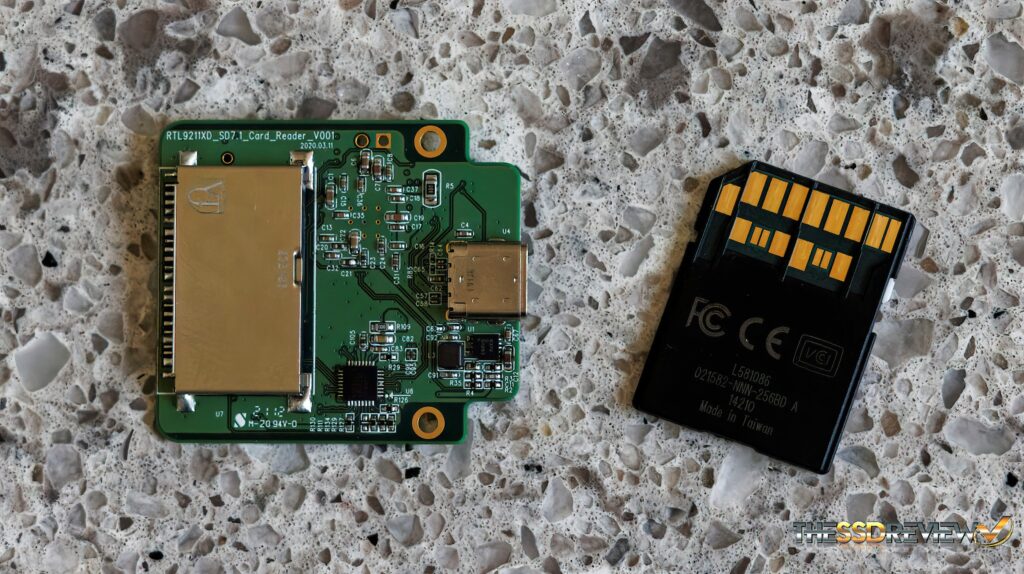It hasn’t been that long now since the introduction of CF Express Type B cards have pushed storage performance to 1750MB/s in the media industry. Media professionals understand that storage speeds are everything; the key thought being that continuous video or photography can only be accomplished with high speed storage concurrent to their activity. Any DSLR owner knows EXACTLY what we mean when we speak of the effects of a filled camera image buffer. Everything slows…or stops. Where we saw CF Express cards solve this problem, SD cards haven’t been able to keep up with maximum speeds of around 300MB/s.
On our Test Bench today is the worlds first SD 7.x spec memory card and it will perform just below 900MB/s, or three times the current standard. This card contains the SMI SM2708 SD Express controller which supports the current UHS-1 standard as well as PCIe Gen 3.0 x 2. It supports the latest 3D NAND memory and with NAND flash interface support up to 1200MT/s, it can fully support Gen 3 x 2 lanes for performance just below 2GB/s as shown in this next photo. As well, the SM2708 meets SD 8.0 spec, contains SMI proprietary NANDXtend ECC, internal data path protection and supports 2 NAND channels with 8CE.
In developing the SM2708, one of the conditions was that it must be completely backwards compatible to the UHS-1 standard and also fully support PCIe 3.0. This is determined by the amount of power sent to the SD card initially with 1.8V being the point where the switch is flipped. If less than 1.8V is available, the card operates in UHS legacy mode while powering it at 1.8V enables PCIe 3 NVMe mode.

A quick look at our sample card supplied by MSI shows that the pin layout for the SD 7.x spec is exactly the same as that of the UHS memory cards of today. Once things move to the SD 8.0 spec, there will be a third row of pins to account for two PCIe lanes.
In order to test the sample SD Express card, we were also provided with a prototype Realtek USB SD Express Gen 3 x 1 reader. This is a single lane reader capable of top UHS speeds as well as SD Express read and write performance just below 1GB/s.
On the top we can see the card insert, Type-C port, and as well, the ic (integrated circuit) located on the lower portion in the center of the card which is the Realtek RTS5261 SD Express controller capable of supporting up to 128TB at speeds of 1GB/s.
The larger chip on the bottom of the reader is the Realtek RTL9211DS USB to SD Express interface which enables up to USB 3.2 Gen II to PCIe 3.0 x 2 transfer of speeds up to 16Gbps bandwidth, or just under 2Gbps. Realtek has provided a roadmap showing a future release capable of speeds up to 4GB/s when using Gen4x2. Currently the RTL9211 chip is the only available capable of supporting ASPM (Active State Power management).
Both ADATA and Lexar are currently developing new SD Express cards in the SD 7.0 specification and we anticipate capacities of both 256 and 512GB to be available with speeds of 800MB/s or higher. microSD Express cards are being developed in tandem with SD Express cards, however, they will be restricted to the 1GB/s level given size considerations.
Let’s flip the page and look at some performance specs for the new SMI SM22708…
 The SSD Review The Worlds Dedicated SSD Education and Review Resource |
The SSD Review The Worlds Dedicated SSD Education and Review Resource | 

too bad the tests were performed via an usb-bridge in between – actually, I had hoped for a direct NVMe connection. especially for latency-sensitive workloads this should matter quite a lot.